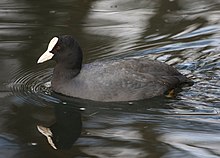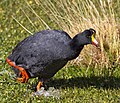Coot
Coot
Genus of birds
Coots are medium-sized water birds that are members of the rail family, Rallidae. They constitute the genus Fulica, the name being the Latin term for "coot". Coots have predominantly black plumage, and—unlike many rails—they are usually easy to see, often swimming in open water.
This article needs additional citations for verification. (July 2010) |
| Coot Temporal range: Early Pliocene to present | |
|---|---|
 | |
| Eurasian coot (Fulica atra) | |
| Scientific classification | |
| Domain: | Eukaryota |
| Kingdom: | Animalia |
| Phylum: | Chordata |
| Class: | Aves |
| Order: | Gruiformes |
| Family: | Rallidae |
| Genus: | Fulica Linnaeus, 1758 |
| Type species | |
| Fulica atra (Eurasian coot) Linnaeus, 1758 | |
| Species | |
For extinct and prehistoric species, see article text | |
The genus Fulica was introduced in 1758 by the Swedish naturalist Carl Linnaeus in the tenth edition of his Systema Naturae.[1] The genus name is the Latin word for a Eurasian coot.[2] The name was used by the Swiss naturalist Conrad Gessner in 1555.[3] The type species is the Eurasian coot.[4]
A group of coots are referred to as a covert[5] or cover.[6]
Species
The genus contains 10 extant species and one which is now extinct.[7]
| Image | Scientific name | Common name | Distribution |
|---|---|---|---|
 | Fulica alai Peale, 1848 | Hawaiian coot or ʻAlae keʻokeʻo | Hawaii |
 | Fulica americana Gmelin, 1789 | American coot | southern Quebec to the Pacific coast of North America and as far south as northern South America |
 | Fulica ardesiaca Tschudi, 1843 | Andean coot | Argentina, Bolivia, Chile, Colombia, Ecuador, Peru |
 | Fulica armillata Vieillot, 1817 | red-gartered coot | Argentina, southern Brazil, Chile, Paraguay, Uruguay |
 | Fulica atra Linnaeus, 1758 | Eurasian coot or common coot | Europe, Asia, Australia, and Africa |
 | Fulica cornuta Bonaparte, 1853 | horned coot | Argentina, Bolivia, Chile |
 | Fulica cristata Gmelin, 1789 | red-knobbed coot | Africa, Iberian Peninsula |
 | Fulica gigantea Eydoux & Souleyet, 1841 | giant coot | Argentina, Bolivia, Chile, Peru |
 | Fulica leucoptera Vieillot, 1817 | white-winged coot | Argentina, Bolivia, Brazil, Chile, Falkland Islands, Paraguay, Uruguay |
 | Fulica rufifrons Philppi & Landbeck, 1861 | red-fronted coot | Argentina, southern Brazil, Chile, Paraguay, southern Peru, Uruguay |
Extinct species
Recently extinct species
- †Fulica newtonii Milne-Edwards, 1867 – Mascarene coot (extinct, c. 1700)
Late Quaternary species
- †Fulica chathamensis Forbes, 1892 – Chatham Island coot (early Holocene of the Chatham Islands)
- †Fulica montanei Alarcón-Muñoz, Labarca & Soto-Acuña, 2020 (late Pleistocene to early Holocene of Chile)[8]
- †Fulica prisca Hamilton, 1893 – New Zealand coot (early Holocene of New Zealand)
- †Fulica shufeldti – (late Pleistocene of Florida) possibly a paleosubspecies of Fulica americana; formerly F. minor
Fossil species
- †Fulica infelix Brodkorb, 1961 – (early Pliocene of Juntura, Malheur County, Oregon, USA)
Coots have prominent frontal shields or other[which?] decoration on the forehead, with red to dark red eyes and coloured bills. Many have white on the under tail. The featherless shield gave rise to the expression "as bald as a coot", which the Oxford English Dictionary cites in use as early as 1430. Like other rails, they have long, lobed toes that are well adapted to soft, uneven surfaces. Coots have strong legs and can walk and run vigorously. They tend to have short, rounded wings and are weak fliers, though northern species nevertheless can cover long distances. They typically congregate in large rafts in open water. They are socially gregarious and messy aquatic feeders. [citation needed]
The greatest species variety occurs in South America, and the genus likely[weasel words] originated there. They are common in Europe and North America.[9] Coot species that migrate do so at night. The American coot has been observed rarely in Britain and Ireland, while the Eurasian coot is found across Asia, Australia and parts of Africa. In southern Louisiana, the coot is referred to by the French name "poule d'eau", which translates into English as "water hen".[10]
Coots are omnivorous, eating mainly plant material, but also small animals, fish and eggs. They are aggressively territorial during the breeding season, but are otherwise often found in sizeable flocks on the shallow vegetated lakes they prefer.
Chick mortality occurs mainly due to starvation rather than predation as coots have difficulty feeding a large family of hatchlings on the tiny shrimp and insects that they collect. Many chicks die in the first 10 days after hatching, when they are most dependent on adults for food.[11] Coots can be very brutal to their own young under pressure such as the lack of food, and after about three days they start attacking their own chicks when they beg for food. After a short while, these attacks concentrate on the weaker chicks, who eventually give up begging and die. The coot may eventually raise only two or three out of nine hatchlings.[12] In this attacking behaviour, the parents are said to "tousle" their young. This can result in the death of the chick.[13]
- Linnaeus, Carl (1758). Systema Naturae per regna tria naturae, secundum classes, ordines, genera, species, cum characteribus, differentiis, synonymis, locis (in Latin). Vol. 1 (10th ed.). Holmiae (Stockholm): Laurentii Salvii. p. 152.
- Jobling, James A. (2010). The Helm Dictionary of Scientific Bird Names. London: Christopher Helm. p. 165. ISBN 978-1-4081-2501-4.
- Peters, James Lee, ed. (1934). Check-List of Birds of the World. Vol. 2. Cambridge, Massachusetts: Harvard University Press. p. 211.
- "What do you call a group of ...?". Oxford Dictionaries. Oxford University Press. Archived from the original on May 1, 2011. Retrieved 19 April 2011.
- "Baltimore Bird Club. Group Name for Birds: A Partial List". Retrieved 2007-06-03.
- Gill, Frank; Donsker, David; Rasmussen, Pamela, eds. (July 2021). "Flufftails, finfoots, rails, trumpeters, cranes, limpkin". IOC World Bird List Version 11.2. International Ornithologists' Union. Retrieved 19 August 2021.
- Alarcón-Muñoz, Jhonatan; Labarca, Rafael; Soto-Acuña, Sergio (2020-12-01). "The late Pleistocene–early Holocene rails (Gruiformes: Rallidae) of Laguna de Tagua Tagua Formation, central Chile, with the description of a new extinct giant coot". Journal of South American Earth Sciences. 104: 102839. Bibcode:2020JSAES.10402839A. doi:10.1016/j.jsames.2020.102839. S2CID 225031984.
- Olson, Storrs L. (1974). "The Pleistocene Rails of North America." Museum of Natural History.
- "This Coot has a Secret! - NatureOutside". 20 June 2015.
- The Life of Birds, David Attenborough. The Problems of Parenthood. 10:20.
- Coot videos on the Internet Bird Collection
- Beach, Chandler B., ed. (1914). "Coot" . The New Student's Reference Work . Chicago: F. E. Compton and Co.